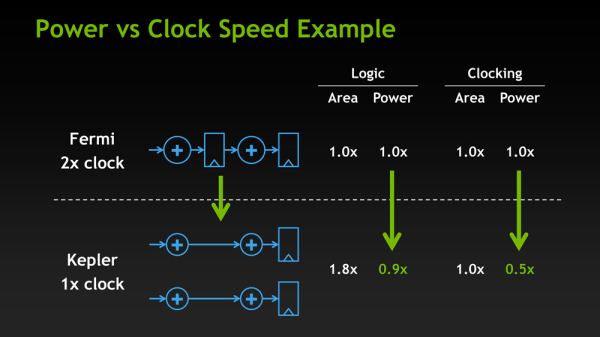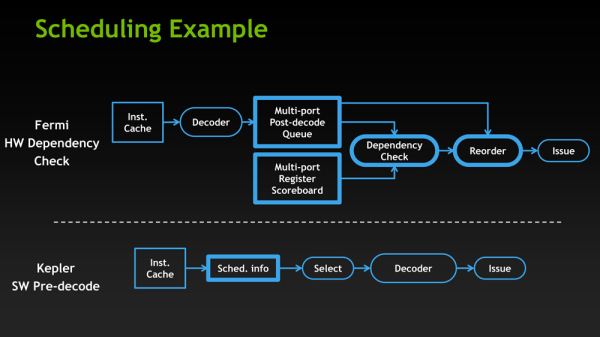NVIDIA GeForce GTX 680 Review: Retaking The Performance Crown
by Ryan Smith on March 22, 2012 9:00 AM ESTThe Kepler Architecture: Efficiency & Scheduling
So far we’ve covered how NVIDIA has improved upon Fermi for; now let’s talk about why.
Mentioned quickly in our introduction, NVIDIA’s big push with Kepler is efficiency. Of course Kepler needs to be faster (it always needs to be faster), but at the same time the market is making a gradual shift towards higher efficiency products. On the desktop side of matters GPUs have more or less reached their limits as far as total power consumption goes, while in the mobile space products such as Ultrabooks demand GPUs that can match the low power consumption and heat dissipation levels these devices were built around. And while strictly speaking NVIDIA’s GPUs haven’t been inefficient, AMD has held an edge on performance per mm2 for quite some time, so there’s clear room for improvement.
In keeping with that ideal, for Kepler NVIDIA has chosen to focus on ways they can improve Fermi’s efficiency. As NVIDIA's VP of GPU Engineering, Jonah Alben puts it, “[we’ve] already built it, now let's build it better.”
There are numerous small changes in Kepler that reflect that goal, but of course the biggest change there was the removal of the shader clock in favor of wider functional units in order to execute a whole warp over a single clock cycle. The rationale for which is actually rather straightforward: a shader clock made sense when clockspeeds were low and die space was at a premium, but now with increasingly small fabrication processes this has flipped. As we have become familiar with in the CPU space over the last decade, higher clockspeeds become increasingly expensive until you reach a point where they’re too expensive – a point where just distributing that clock takes a fair bit of power on its own, not to mention the difficulty and expense of building functional units that will operate at those speeds.
With Kepler the cost of having a shader clock has finally become too much, leading NVIDIA to make the shift to a single clock. By NVIDIA’s own numbers, Kepler’s design shift saves power even if NVIDIA has to operate functional units that are twice as large. 2 Kepler CUDA cores consume 90% of the power of a single Fermi CUDA core, while the reduction in power consumption for the clock itself is far more dramatic, with clock power consumption having been reduced by 50%.
Of course as NVIDIA’s own slide clearly points out, this is a true tradeoff. NVIDIA gains on power efficiency, but they lose on area efficiency as 2 Kepler CUDA cores take up more space than a single Fermi CUDA core even though the individual Kepler CUDA cores are smaller. So how did NVIDIA pay for their new die size penalty?
Obviously 28nm plays a significant part of that, but even then the reduction in feature size from moving to TSMC’s 28nm process is less than 50%; this isn’t enough to pack 1536 CUDA cores into less space than what previously held 384. As it turns out not only did NVIDIA need to work on power efficiency to make Kepler work, but they needed to work on area efficiency. There are a few small design choices that save space, such as using 8 SMXes instead of 16 smaller SMXes, but along with dropping the shader clock NVIDIA made one other change to improve both power and area efficiency: scheduling.
GF114, owing to its heritage as a compute GPU, had a rather complex scheduler. Fermi GPUs not only did basic scheduling in hardware such as register scoreboarding (keeping track of warps waiting on memory accesses and other long latency operations) and choosing the next warp from the pool to execute, but Fermi was also responsible for scheduling instructions within the warps themselves. While hardware scheduling of this nature is not difficult, it is relatively expensive on both a power and area efficiency basis as it requires implementing a complex hardware block to do dependency checking and prevent other types of data hazards. And since GK104 was to have 32 of these complex hardware schedulers, the scheduling system was reevaluated based on area and power efficiency, and eventually stripped down.
The end result is an interesting one, if only because by conventional standards it’s going in reverse. With GK104 NVIDIA is going back to static scheduling. Traditionally, processors have started with static scheduling and then moved to hardware scheduling as both software and hardware complexity has increased. Hardware instruction scheduling allows the processor to schedule instructions in the most efficient manner in real time as conditions permit, as opposed to strictly following the order of the code itself regardless of the code’s efficiency. This in turn improves the performance of the processor.
However based on their own internal research and simulations, in their search for efficiency NVIDIA found that hardware scheduling was consuming a fair bit of power and area for few benefits. In particular, since Kepler’s math pipeline has a fixed latency, hardware scheduling of the instruction inside of a warp was redundant since the compiler already knew the latency of each math instruction it issued. So NVIDIA has replaced Fermi’s complex scheduler with a far simpler scheduler that still uses scoreboarding and other methods for inter-warp scheduling, but moves the scheduling of instructions in a warp into NVIDIA’s compiler. In essence it’s a return to static scheduling.
Ultimately it remains to be seen just what the impact of this move will be. Hardware scheduling makes all the sense in the world for complex compute applications, which is a big reason why Fermi had hardware scheduling in the first place, and for that matter why AMD moved to hardware scheduling with GCN. At the same time however when it comes to graphics workloads even complex shader programs are simple relative to complex compute applications, so it’s not at all clear that this will have a significant impact on graphics performance, and indeed if it did have a significant impact on graphics performance we can’t imagine NVIDIA would go this way.
What is clear at this time though is that NVIDIA is pitching GTX 680 specifically for consumer graphics while downplaying compute, which says a lot right there. Given their call for efficiency and how some of Fermi’s compute capabilities were already stripped for GF114, this does read like an attempt to further strip compute capabilities from their consumer GPUs in order to boost efficiency. Amusingly, whereas AMD seems to have moved closer to Fermi with GCN by adding compute performance, NVIDIA seems to have moved closer to Cayman with Kepler by taking it away.
With that said, in discussing Kepler with NVIDIA’s Jonah Alben, one thing that was made clear is that NVIDIA does consider this the better way to go. They’re pleased with the performance and efficiency they’re getting out of software scheduling, going so far to say that had they known what they know now about software versus hardware scheduling, they would have done Fermi differently. But whether this only applies to consumer GPUs or if it will apply to Big Kepler too remains to be seen.












404 Comments
View All Comments
saturn85 - Tuesday, March 27, 2012 - link
can we have folding@home benchmark?warmbit - Tuesday, March 27, 2012 - link
I invite you to the statement of GTX680 card performance based on the results of the eight websites (tom's too):http://translate.google.pl/translate?hl=pl&sl=...
lhotdeals - Wednesday, March 28, 2012 - link
I never posted a reply to reviews... but the conclusion of this review leaves me baffled. It is clear that 680 has its advantages, but looking at the numbers, the 680 and 7970 trades punches pretty equally in terms of performance. 680 does beat the 7970 in power usage and noise level, but the actual lead is miniscue...I do not see how the reviewer can reach the dominating position of the 680 in the conclusion... It is nothing but misleading to an otherwise great review with tons of data points.
sngbrdb - Wednesday, March 28, 2012 - link
"...at the end of the day it’s NVIDIA who once again takes the performance crown for the highest performing single-GPU card."Are you kidding me?? Are we looking at the same charts? This card only "excels" on the lower end of resolution and quality settings. And in many of your charts, the cards that beat it in higher resolutions are conspicuously absent in the lower-resolution charts (the GTX 590 and Radeon 6990 are frequently missing).
GPU reviews need to be written by someone who isn't biased toward a brand, and Mr. Smith, that is clearly not you.
CeriseCogburn - Thursday, March 29, 2012 - link
Sorry, you can't lie to yourself forever - how about a massive database with percentages and totals from many reviews...http://translate.google.pl/translate?hl=pl&sl=...
At the highest resolutions amd still loses. Amd also loses the lower and lowest Enjoy.
sngbrdb - Friday, March 30, 2012 - link
My comments are about the conclusions Mr. Smith draws form the charts he displays, not about whether the card does better elsewhere. The charts that Mr. Smith shows and the conclusions he draws from them are not logical... there may be other data out there that supports his conclusions, but that would mean the data he's displaying here is flawed/inaccurate. Either way, you can't look at those charts and act like the 680 has slaughtered AMD, you end up sounding like a fanboy.And charts need to be consistent about the cards being compared... you can't put a card in the chart for one resolution, and leave it out in another.
CeriseCogburn - Friday, March 30, 2012 - link
Yes, and anandtech's charts percentages are at the link I provided, that prove you incorrect, period.Reality doesn't make anyone a fanboy.Ignoring reality does.
_vor_ - Saturday, March 31, 2012 - link
So does replying to nearly all 40 pages of discussion flagrantly waving the NVIDIA banner. Maybe you need to look up the word hypocrisy.CeriseCogburn - Friday, April 6, 2012 - link
Vor you're angry because you got caught waving the amd flag * incorrectly*.There wouldn't be a need if there wasn't false information being spread about.
It's no wonder it happens when the amd card loses.
Addressing it is helpful and the right thing to do.
sngbrdb - Monday, April 9, 2012 - link
Um.... the charts at the link you provided point back to this article. Please do your research before being rude.From the article:
---------------------------------
Sources of data:
...
Anandtech - www.anandtech.com/show/5699/nvidia-geforce-gtx-680-review